A Quasi-2D Exploration of Mixed-Mode Fracture Propagation in Concrete Semi-Circular Chevron-Notched Disks
Abstract
:1. Introduction
2. Experimental and Numerical Methods
2.1. Specification of Concrete SCCND
2.2. SCB Tests for Concrete SCCND
2.3. Numerical Simulation of SCB Tests
2.4. Methods for Fracture Analysis
3. Results and Discussion
3.1. Maximum Failure Load
3.2. Chevron-Notch and Fracturing Angles
3.3. Stress Distributions in SCCND by FRANC2D
3.4. Fracturing in SCCND Simulated by FRANC2D
3.5. CMOD Determined by SCB Tests
3.6. SIF and Fracture Toughness
3.7. Limitations and Prospects
4. Summary and Concluding Remarks
- Concrete SCB tests with SCCND specimens with a sharp notch tip are reliable and robust for studying mixed-mode (types I and II) fracture propagation in concrete because of their reliable results and relatively small standard deviations of all testing variables.
- The maximum failure load (Pmax) increases with increasing inclination angle (β).
- The fracture propagation angle (θ) also increases with increasing β, and the phenomenon of wing fractures can be observed.
- As powerful software for linear elastic fracture mechanics, FRANC2D can successfully simulate SCB tests with the same loading conditions in terms of fracture propagation in SCCND specimens.
- Despite the fact that the compressive normal stress concentrations in the SCCND specimen are adjacent to the three loading points, most variations of the normal stress distributions occur around the prefabricated chevron notch.
- With increasing β, the tensile stress concentration around the notch tip moves toward the upper face of the notch, and the compressive stress concentration forms at the notch tip to turn the tensile loading mode into the shearing one.
- The stress distributions along the upper and lower faces of the chevron notch can be produced by FRANC2D for quantitative analysis, and this stress analysis also verifies the previous findings about stress-distribution variations.
- The tensile mode (type I) can be generated when β = 0–30° because the CMOD increases, indicating the crack opening under tensile loading. In contrast, the mixed mode (types I and II) becomes more evident for β = 45–70°, with the CMOD decreasing, indicating the crack closing under both tensile and shearing loading conditions.
- The FPZ can be found for β = 0–30° but not for β = 45–70°, which basically agrees with the CCNBD tests simulated in a previous numerical study.
- The tensile SIF decreases monotonically with increasing β, whereas the shear SIF increases from zero for β = 0° to a peak value for β = 45–60° and then decreases when β is increased to 70°.
- Four fracture criteria—MTS, G, GMTS, and EMTSN—were examined against the experimental results. The GMTS and EMTSN criteria outperform the MTS and G ones. In particular, compared with the experimental results, the newly developed EMTSN criterion characterizes most precisely the critical fracture toughness of both tensile and shearing (KIc and KIIc).
- There is a linear relationship between CMOD and KI for concrete SCB tests. However, because it has been examined for both asphalt and concrete, it deserves further investigation for other brittle materials.
Author Contributions
Funding
Data Availability Statement
Acknowledgments
Conflicts of Interest
References
- Walton, W. Brittle Materials. Nature 1958, 181, 1577–1579. [Google Scholar] [CrossRef]
- Lemaitre, J.; Desmorat, R. Failure of Brittle and Quasi-Brittle Materials. In Engineering Damage Mechanics; Springer: Berlin/Heidelberg, Germany, 2005; pp. 321–371. [Google Scholar]
- Griffith, A.A., VI. The phenomena of rupture and flow in solids. Philos. Trans. R. Soc. Lond. Contain. Pap. Math. Phys. Character 1921, 221, 163–198. [Google Scholar]
- Whittaker, B.N.; Singh, R.N.; Sun, G. Rock Fracture Mechanics. Principles, Design and Applications; Elsevier: Amsterdam, The Netherlands, 1992. [Google Scholar]
- Barenblatt, G. Equilibrium cracks formed during brittle fracture rectilinear cracks in plane plates. J. Appl. Math. Mech. 1959, 23, 1009–1029. [Google Scholar] [CrossRef]
- Dugdale, D.S. Yielding of steel sheets containing slits. J. Mech. Phys. Solids 1960, 8, 100–104. [Google Scholar] [CrossRef]
- Lawn, B.R. Fracture of brittle solids. In Cambridge Solid State Science Series; Cambridge University Press: Cambridge, UK, 1993. [Google Scholar]
- Lim, I.; Johnston, I.; Choi, S. Stress intensity factors for semi-circular specimens under three-point bending. Eng. Fract. Mech. 1993, 44, 363–382. [Google Scholar] [CrossRef]
- Shah, S.P.; Swartz, S.E.; Ouyang, C. Fracture Mechanics of Concrete: Applications of Fracture Mechanics to Concrete, Rock and Other Quasi-Brittle Materials; John Wiley & Sons: Hoboken, NJ, USA, 1995. [Google Scholar]
- Bocca, P.; Carpinteri, A.; Valente, S. Mixed mode fracture of concrete. Int. J. Solids Struct. 1991, 27, 1139–1153. [Google Scholar] [CrossRef]
- Sih, G.C. Strain-energy-density factor applied to mixed mode crack problems. Int. J. Fract. 1974, 10, 305–321. [Google Scholar] [CrossRef]
- Shen, B.; Stephansson, O. Cyclic loading characteristics of joints and rock bridges in a jointed rock specimen. In Proceedings of the International Symposium on Rock Joints, Loen, Norway, 4–6 June 1990; pp. 725–729. [Google Scholar]
- Lim, W.K.; Lee, C.S. Evaluation of stress intensity factors for a crack normal to bimaterial interface using isoparametric finite elements. Eng. Fract. Mech. 1995, 52, 65–70. [Google Scholar]
- Erarslan, N. Analysing mixed mode (I–II) fracturing of concrete discs including chevron and straight-through notch cracks. Int. J. Solids Struct. 2019, 167, 79–92. [Google Scholar] [CrossRef]
- Ayatollahi, M.; Aliha, M.; Saghafi, H. An improved semi-circular bend specimen for investigating mixed mode brittle fracture. Eng. Fract. Mech. 2011, 78, 110–123. [Google Scholar] [CrossRef]
- Shi, Z. Crack Analysis in Structural Concrete: Theory and Applications; Butterworth-Heinemann: Oxford, UK, 2009. [Google Scholar]
- Bažant, Z.P.; Oh, B.H. Crack band theory for fracture of concrete. Matériaux Constr. 1983, 16, 155–177. [Google Scholar] [CrossRef]
- Mirsayar, M.; Razmi, A.; Berto, F. Tangential strain-based criteria for mixed-mode I/II fracture toughness of cement concrete. Fatigue Fract. Eng. Mater. Struct. 2018, 41, 129–137. [Google Scholar] [CrossRef]
- Aliha, M.; Mahdavi, E.; Ayatollahi, M. Statistical analysis of rock fracture toughness data obtained from different chevron notched and straight cracked mode I specimens. Rock Mech. Rock Eng. 2018, 51, 2095–2114. [Google Scholar] [CrossRef]
- Xu, Y.; Dai, F.; Zhao, T.; Xu, N.-W.; Liu, Y. Fracture toughness determination of cracked chevron notched Brazilian disc rock specimen via Griffith energy criterion incorporating realistic fracture profiles. Rock Mech. Rock Eng. 2016, 49, 3083–3093. [Google Scholar] [CrossRef]
- Luo, L.; Erarslan, N.; Mu, Z. Mixed-Mode Fracturing of Concrete—Numerical and Experimental Study using SCCD Specimens. In Recent Advances in Material, Analysis, Monitoring, and Evaluation in Foundation and Bridge Engineering; ASCE Library: Reston, VA, USA, 2014; pp. 25–37. [Google Scholar]
- Kuruppu, M.D.; Obara, Y.; Ayatollahi, M.R.; Chong, K.; Funatsu, T. ISRM-suggested method for determining the mode I static fracture toughness using semi-circular bend specimen. Rock Mech. Rock Eng. 2014, 47, 267–274. [Google Scholar] [CrossRef]
- Wawrzynek, P.A.; Ingraffea, A. Interactive finite element analysis of fracture processes: An integrated approach. Theor. Appl. Fract. Mech. 1987, 8, 137–150. [Google Scholar] [CrossRef]
- Henshell, R.; Shaw, K. Crack tip finite elements are unnecessary. Int. J. Numer. Methods Eng. 1975, 9, 495–507. [Google Scholar] [CrossRef]
- Gómez, F.; Elices, M. A fracture criterion for blunted V-notched samples. Int. J. Fract. 2004, 127, 239–264. [Google Scholar] [CrossRef]
- Chen, D.; Ozaki, S. Investigation of failure criteria for a sharp notch. Int. J. Fract. 2008, 152, 63–74. [Google Scholar] [CrossRef]
- Erarslan, N.; Williams, D. Mixed-mode fracturing of rocks under static and cyclic loading. Rock Mech. Rock Eng. 2013, 46, 1035–1052. [Google Scholar] [CrossRef]
- Ayatollahi, M.R.; Aliha, M.R.M.; Hassani, M.M. Mixed mode brittle fracture in PMMA—An experimental study using SCB specimens. Mater. Sci. Eng. A 2006, 417, 348–356. [Google Scholar] [CrossRef]
- Ayatollahi, M.R.; Aliha, M.R.M. On determination of mode II fracture toughness using semi-circular bend specimen. Int. J. Solids Struct. 2006, 43, 5217–5227. [Google Scholar] [CrossRef]
- Kuruppu, M.D.; Chong, K.P. Fracture toughness testing of brittle materials using semi-circular bend (SCB) specimen. Eng. Fract. Mech. 2012, 91, 133–150. [Google Scholar] [CrossRef]
- Ayatollahi, M.R.; Aliha, M.R.M. Wide range data for crack tip parameters in two disc-type specimens under mixed mode loading. Comput. Mater. Sci. 2007, 38, 660–670. [Google Scholar] [CrossRef]
- Chang, S.-H.; Lee, C.-I.; Jeon, S. Measurement of rock fracture toughness under modes I and II and mixed-mode conditions by using disc-type specimens. Eng. Geol. 2002, 66, 79–97. [Google Scholar] [CrossRef]
- Lanaro, F.; Sato, T.; Stephansson, O. Microcrack modelling of Brazilian tensile tests with the boundary element method. Int. J. Rock Mech. Min. Sci. 2009, 46, 450–461. [Google Scholar] [CrossRef]
- Adamson, R.; Dempsey, J.; Mulmule, S. Fracture analysis of semi-circular and semi-circular-bend geometries. Int. J. Fract. 1996, 77, 213–222. [Google Scholar] [CrossRef]
- Mubaraki, M.; Sallam, H. Reliability study on fracture and fatigue behavior of pavement materials using SCB specimen. Int. J. Pavement Eng. 2020, 21, 1563–1575. [Google Scholar] [CrossRef]
- Aliha, M.; Ayatollahi, M.R. Mixed mode I/II brittle fracture evaluation of marble using SCB specimen. Procedia Eng. 2011, 10, 311–318. [Google Scholar] [CrossRef]
- Erdogan, F.; Sih, G. On the crack extension in plates under plane loading and transverse shear. J. Basic Eng. 1963, 85, 519–525. [Google Scholar] [CrossRef]
- Backers, T. Fracture Toughness Determination and Micromechanics of Rock under Mode I and Mode II Loading; GeoForschungsZentrum: Potsdam, Germany, 2005. [Google Scholar]
- Rao, Q.; Sun, Z.; Stephansson, O.; Li, C.; Stillborg, B. Shear fracture (Mode II) of brittle rock. Int. J. Rock Mech. Min. Sci. 2003, 40, 355–375. [Google Scholar] [CrossRef]
- Razmi, A.; Mirsayar, M. On the mixed mode I/II fracture properties of jute fiber-reinforced concrete. Constr. Build. Mater. 2017, 148, 512–520. [Google Scholar] [CrossRef]
- Karimzadeh, H.; Razmi, A.; Imaninasab, R.; Esminejad, A. The influence of natural and synthetic fibers on mixed mode I/II fracture behavior of cement concrete materials. Can. J. Civ. Eng. 2019, 46, 1081–1089. [Google Scholar] [CrossRef]
- Golewski, G.L. Effect of Coarse Aggregate Grading on Mechanical Parameters and Fracture Toughness of Limestone Concrete. Infrastructures 2023, 8, 117. [Google Scholar] [CrossRef]
- Alrayes, O.; Könke, C.; Hamdia, K.M. A Numerical Study of Crack Mixed Mode Model in Concrete Material Subjected to Cyclic Loading. Materials 2023, 16, 1916. [Google Scholar] [CrossRef] [PubMed]
- Sreenath, S.; Mohan, K.S.R.; Murali, G. Fracture Toughness of Reactive Powder Fibrous Concrete Composites under Pure and Mixed Modes (I/III). Buildings 2022, 12, 599. [Google Scholar] [CrossRef]
- Zhu, R.; Gao, H.; Zhan, Y.; Wu, Z.-X. Construction of Discrete Element Constitutive Relationship and Simulation of Fracture Performance of Quasi-Brittle Materials. Materials 2022, 15, 1964. [Google Scholar] [CrossRef]


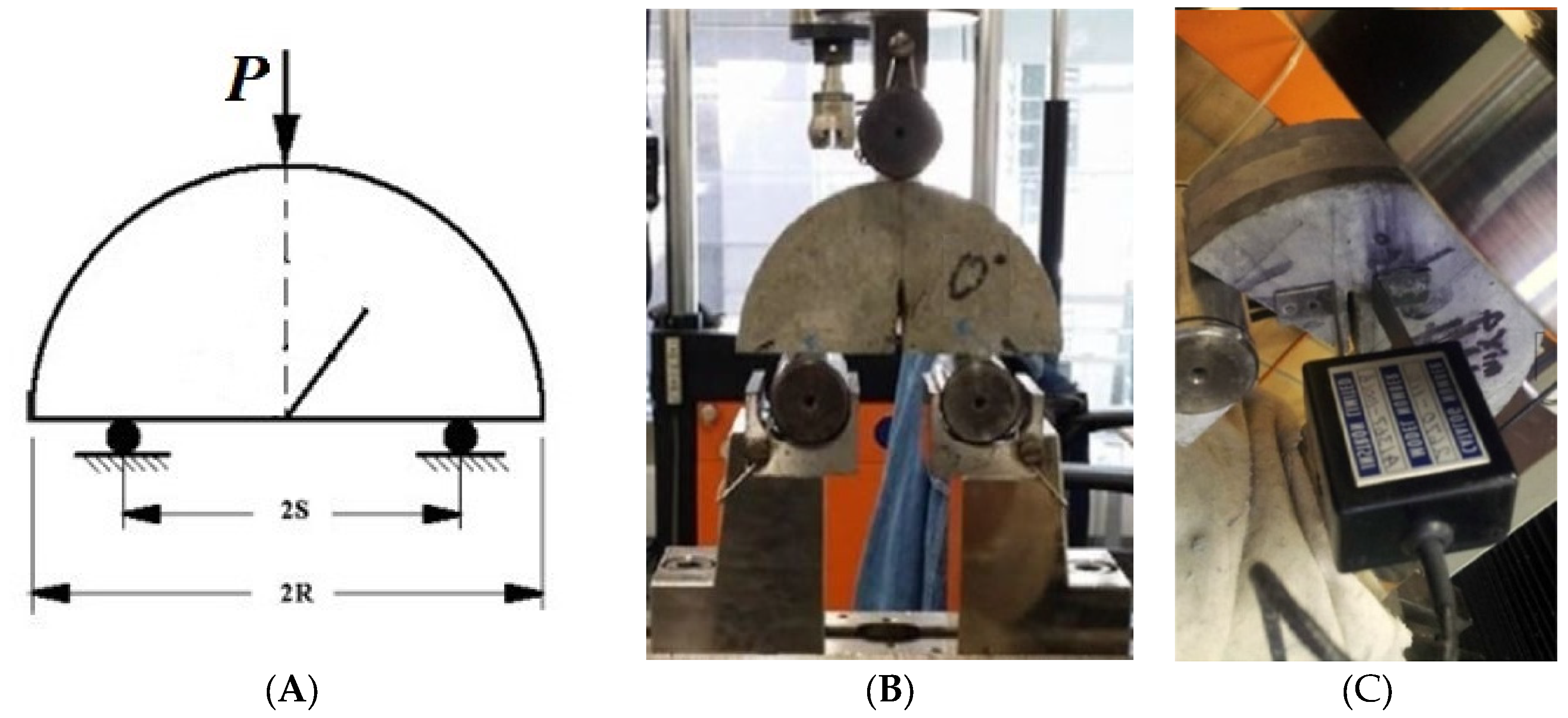

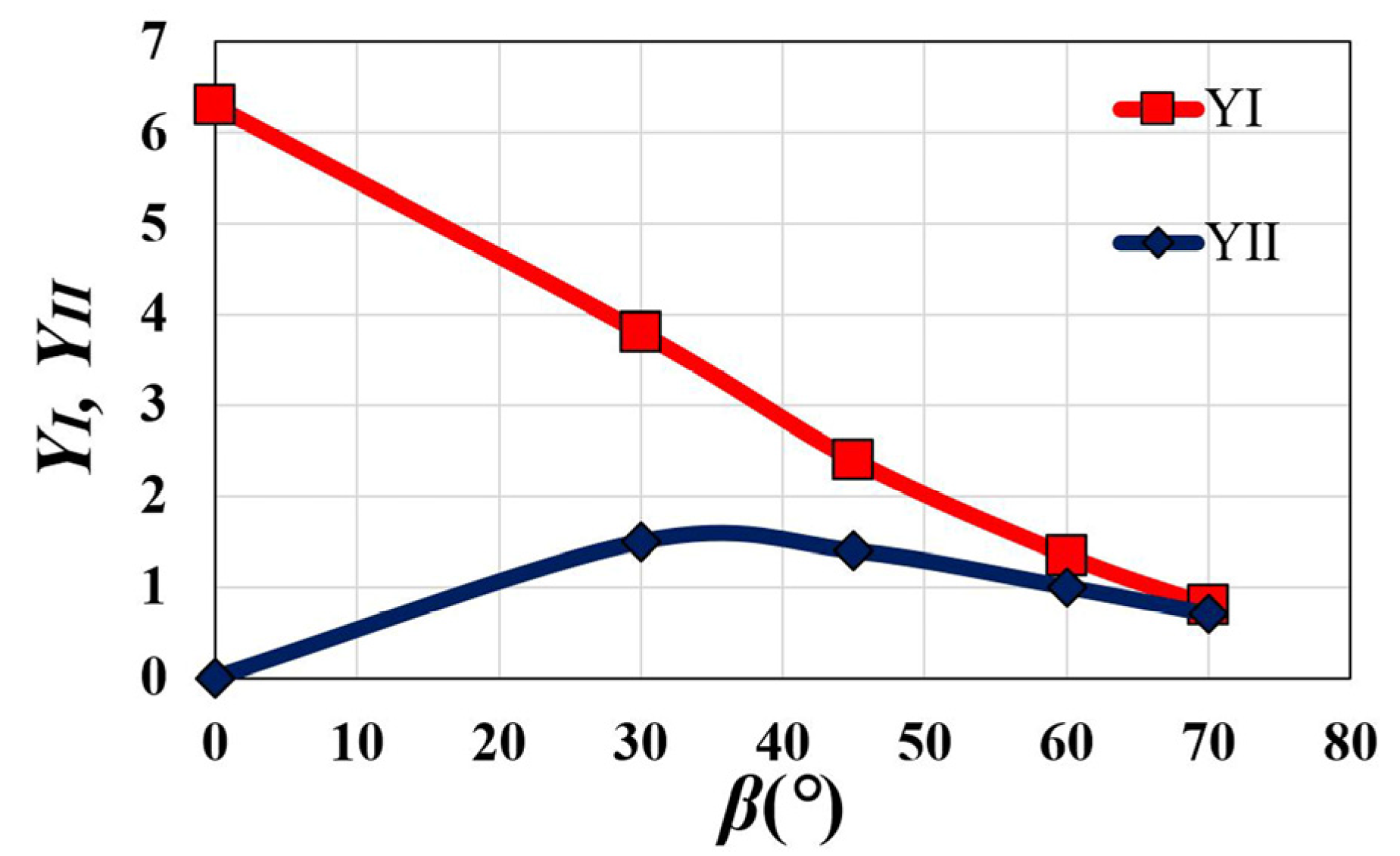

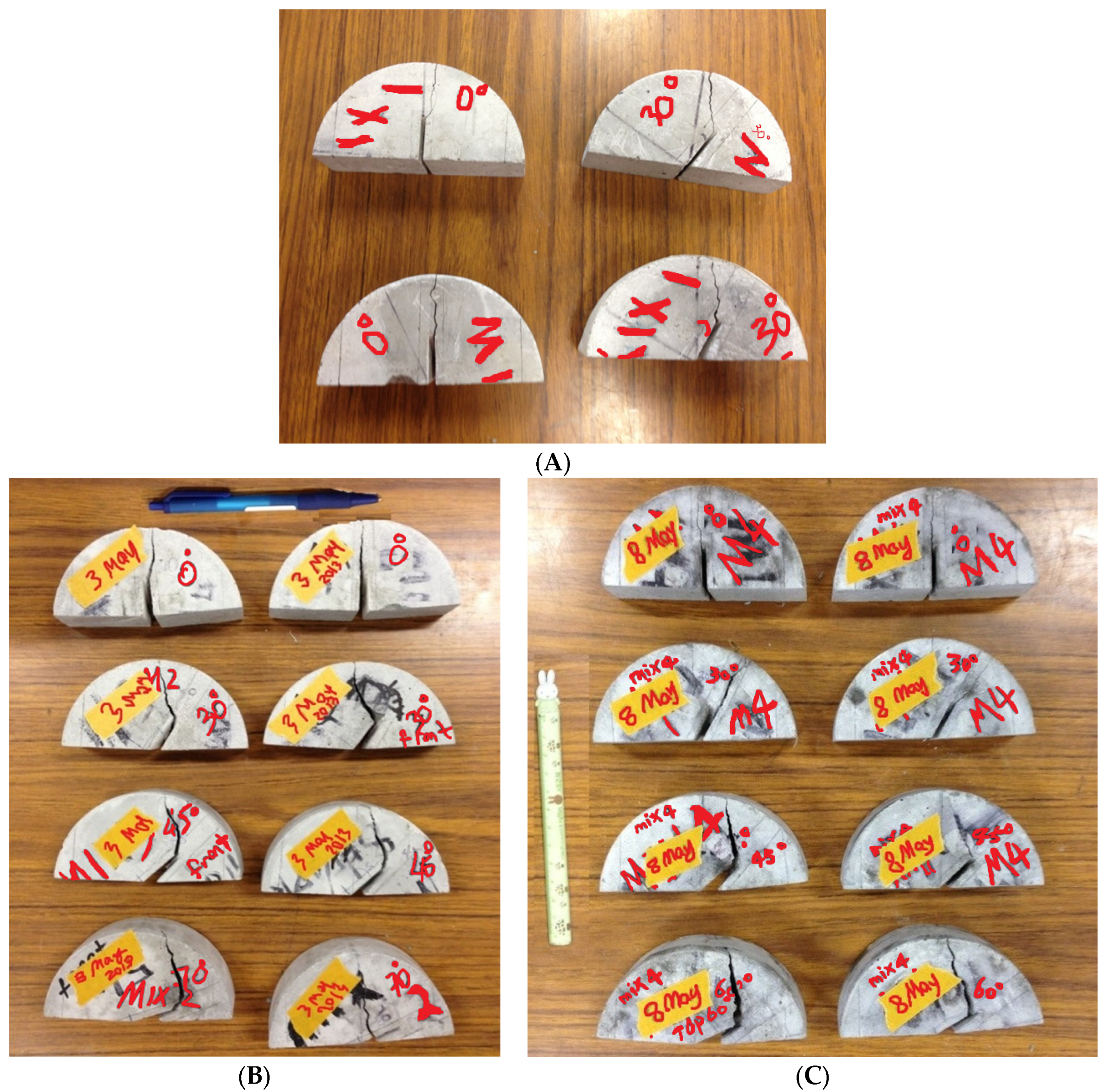

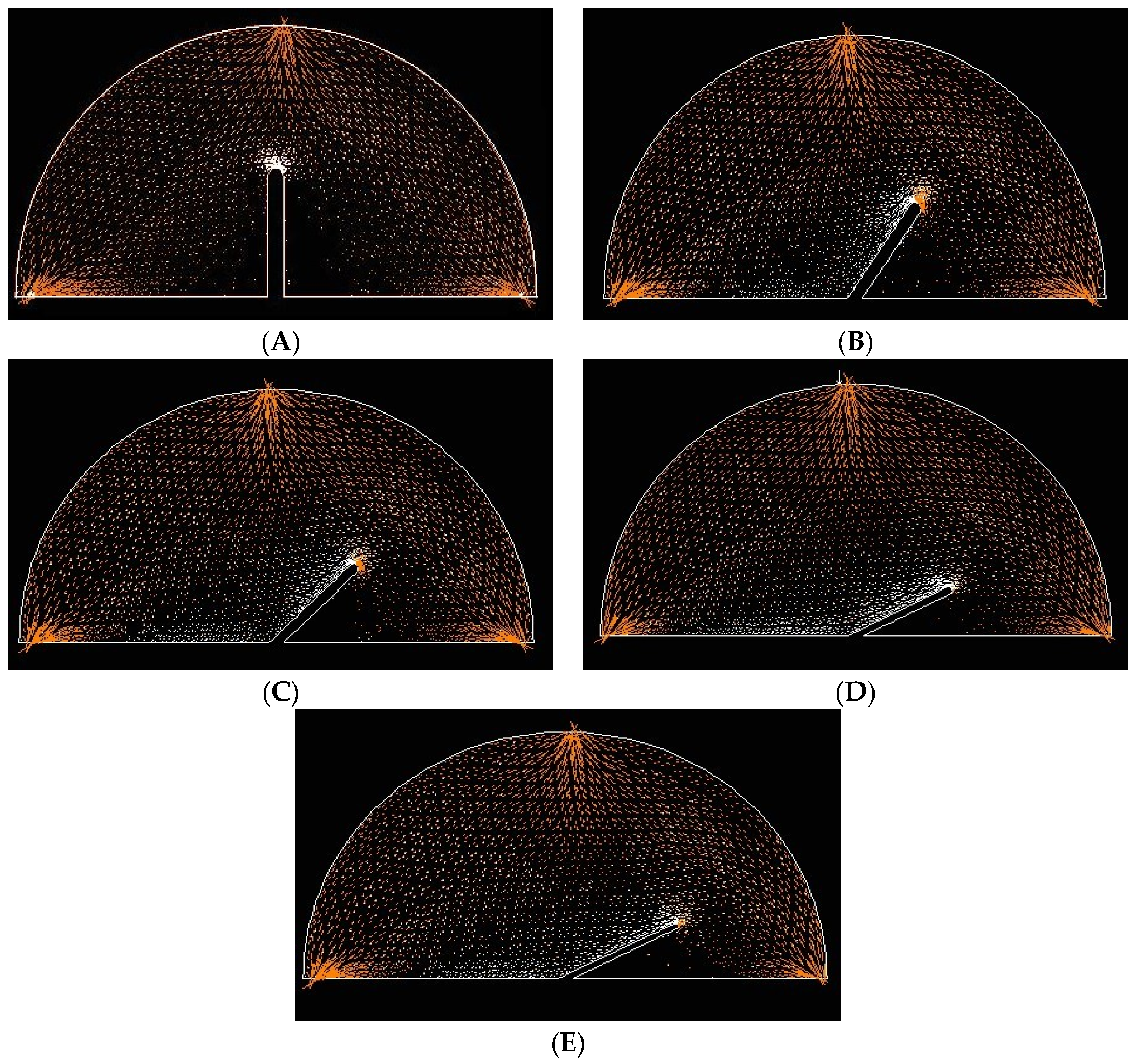
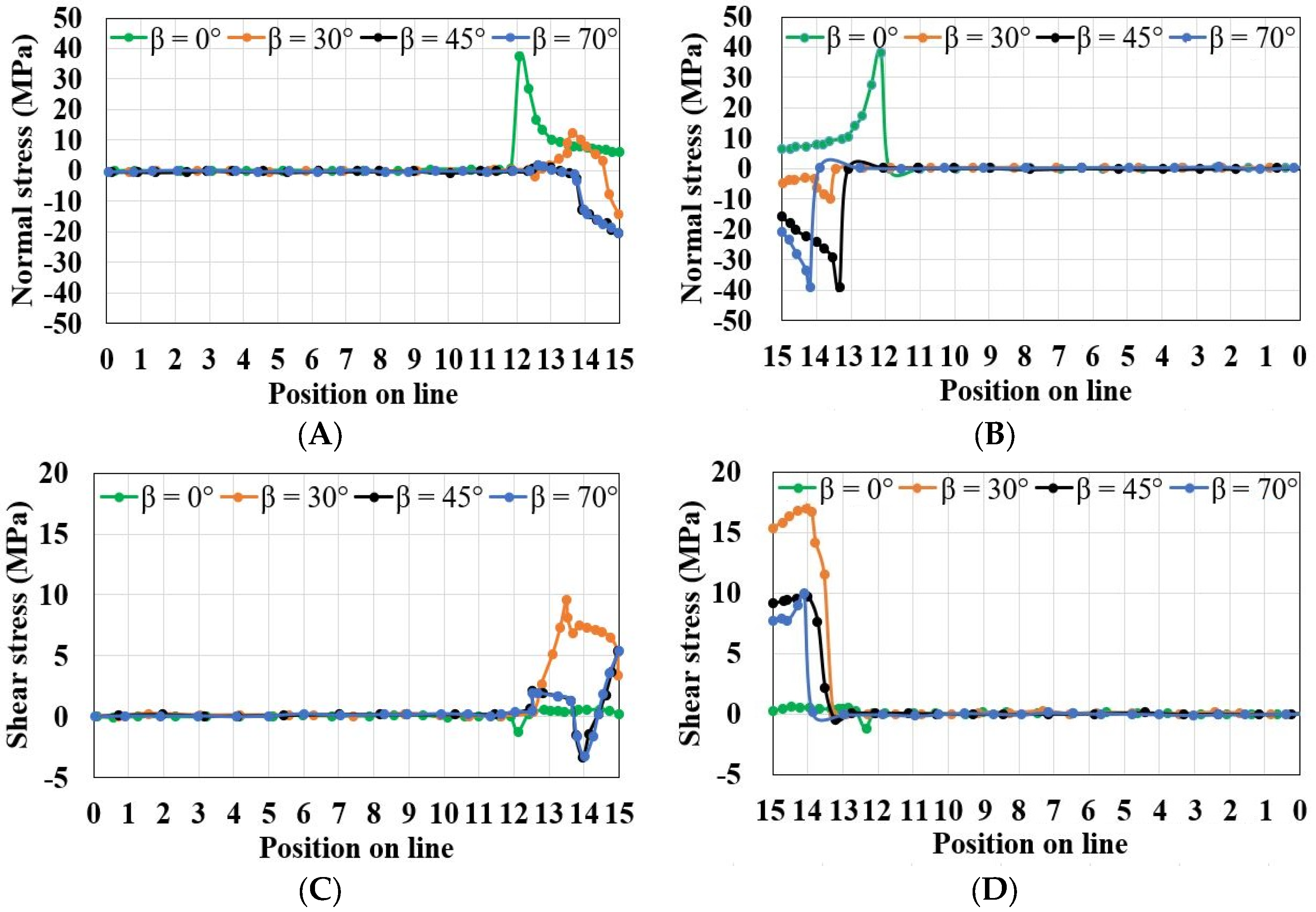
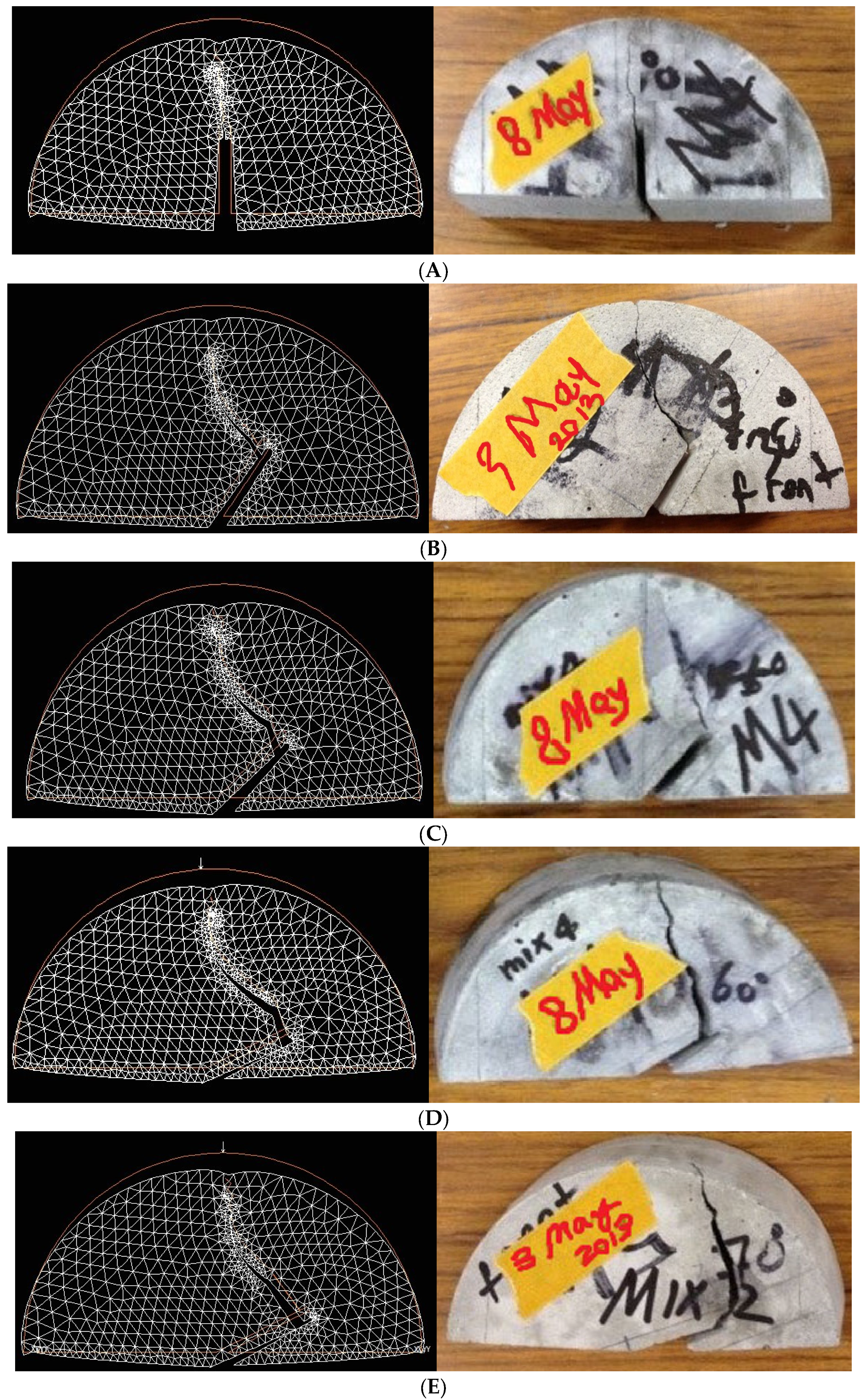



| β | Pmax [kN] | Group 1 | Group 2 | Group 3 | Mean | STD |
|---|---|---|---|---|---|---|
| 0° | First half CCNBD | 0.687 | 0.211 | 0.529 | 0.483 | 0.232 |
| Second half CCNBD | 0.767 | 0.141 | 0.563 | |||
| 30° | First half CCNBD | 0.663 | 0.520 | 0.193 | 0.571 | 0.182 |
| Second half CCNBD | 0.746 | 0.670 | 0.632 | |||
| 45° | First half CCNBD | – | 0.740 | 0.888 | 0.867 | 0.098 |
| Second half CCNBD | – | 0.830 | 1.010 | |||
| 60° | First half CCNBD | – | – | 1.011 | 1.112 | 0.101 |
| Second half CCNBD | – | – | 1.213 | |||
| 70° | First half CCNBD | – | 1.185 | – | 0.983 | 0.203 |
| Second half CCNBD | – | 0.780 | – |
| β | Fracture Propagation Angle (θ) | ||||
|---|---|---|---|---|---|
| Group 1 | Group 2 | Group 3 | Mean | STD | |
| 0° | 0–10° | 0–5° | 2–5° | 4° | 3° |
| 30° | 30–45° | 55–68° | 5–15° | 36° | 22° |
| 45° | – | 38–57° | 55–65° | 54° | 10° |
| 60° | – | – | 78–80° | 79° | 1° |
| 70° | – | 44–96° | 80–96° | 79° | 21° |
| β | 0° | 30° | 45° | 60° | 70° |
|---|---|---|---|---|---|
| θ (FRANC2D) | 2° | 56° | 85° | 95° | 107° |
| θ (Experiment) | 2° | 55° | 65° | 80° | 96° |
| β | [] | Group 1 | Group 2 | Group 3 | Mean | STD |
|---|---|---|---|---|---|---|
| 0° | First half CCNBD | 0.376 | 0.116 | 0.290 | 0.265 | 0.127 |
| Second half CCNBD | 0.420 | 0.077 | 0.308 | |||
| 30° | First half CCNBD | 0.231 | 0.181 | 0.067 | 0.199 | 0.063 |
| Second half CCNBD | 0.260 | 0.233 | 0.220 | |||
| 45° | First half CCNBD | – | 0.151 | 0.181 | 0.177 | 0.020 |
| Second half CCNBD | – | 0.170 | 0.206 | |||
| 60° | First half CCNBD | – | – | 0.119 | 0.131 | 0.012 |
| Second half CCNBD | – | – | 0.142 | |||
| 70° | First half CCNBD | – | 0.082 | – | 0.068 | 0.014 |
| Second half CCNBD | – | 0.054 | – |
| β | [] | Group 1 | Group 2 | Group 3 | Mean | STD |
|---|---|---|---|---|---|---|
| 0° | First half CCNBD | 0.000 | 0.000 | 0.000 | 0.00 | 0.00 |
| Second half CCNBD | 0.000 | 0.000 | 0.000 | |||
| 30° | First half CCNBD | 0.086 | 0.068 | 0.025 | 0.074 | 0.024 |
| Second half CCNBD | 0.097 | 0.087 | 0.082 | |||
| 45° | First half CCNBD | – | 0.084 | 0.100 | 0.098 | 0.011 |
| Second half CCNBD | – | 0.094 | 0.114 | |||
| 60° | First half CCNBD | – | – | 0.088 | 0.097 | 0.009 |
| Second half CCNBD | – | – | 0.105 | |||
| 70° | First half CCNBD | – | 0.072 | – | 0.060 | 0.012 |
| Second half CCNBD | – | 0.047 | – |
Disclaimer/Publisher’s Note: The statements, opinions and data contained in all publications are solely those of the individual author(s) and contributor(s) and not of MDPI and/or the editor(s). MDPI and/or the editor(s) disclaim responsibility for any injury to people or property resulting from any ideas, methods, instructions or products referred to in the content. |
© 2023 by the authors. Licensee MDPI, Basel, Switzerland. This article is an open access article distributed under the terms and conditions of the Creative Commons Attribution (CC BY) license (https://creativecommons.org/licenses/by/4.0/).
Share and Cite
Lu, X.; Yan, G. A Quasi-2D Exploration of Mixed-Mode Fracture Propagation in Concrete Semi-Circular Chevron-Notched Disks. Buildings 2023, 13, 2633. https://doi.org/10.3390/buildings13102633
Lu X, Yan G. A Quasi-2D Exploration of Mixed-Mode Fracture Propagation in Concrete Semi-Circular Chevron-Notched Disks. Buildings. 2023; 13(10):2633. https://doi.org/10.3390/buildings13102633
Chicago/Turabian StyleLu, Xiaoqing, and Guanxi Yan. 2023. "A Quasi-2D Exploration of Mixed-Mode Fracture Propagation in Concrete Semi-Circular Chevron-Notched Disks" Buildings 13, no. 10: 2633. https://doi.org/10.3390/buildings13102633
APA StyleLu, X., & Yan, G. (2023). A Quasi-2D Exploration of Mixed-Mode Fracture Propagation in Concrete Semi-Circular Chevron-Notched Disks. Buildings, 13(10), 2633. https://doi.org/10.3390/buildings13102633








